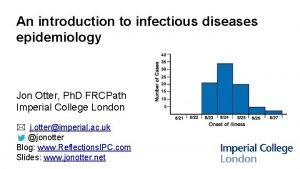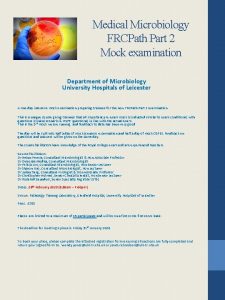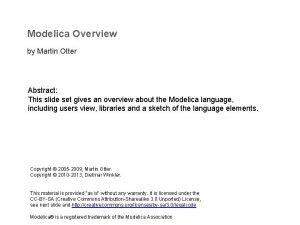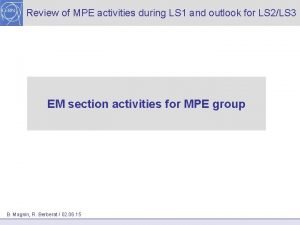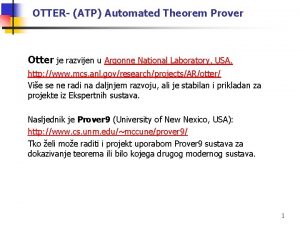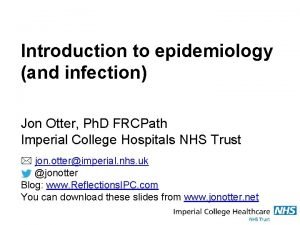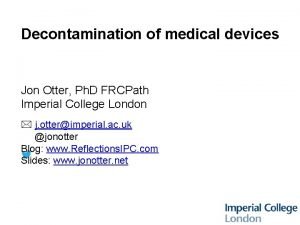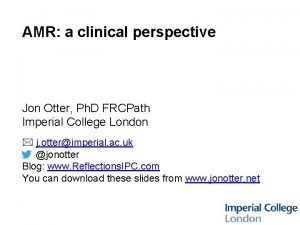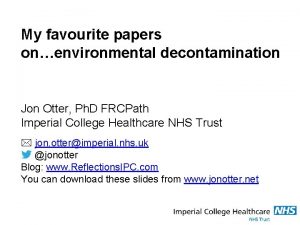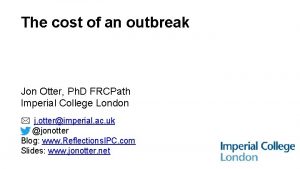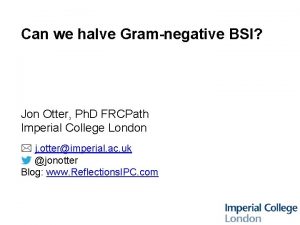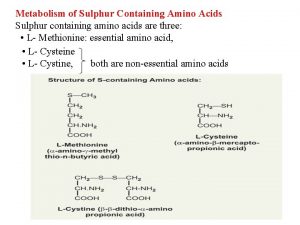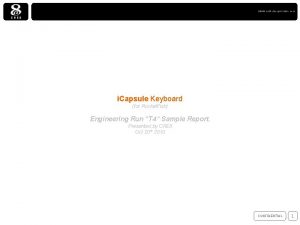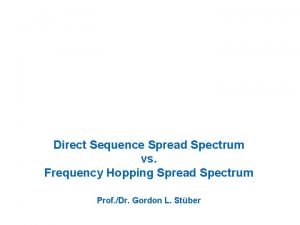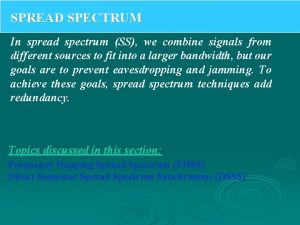Containing CRE spread Jon Otter Ph D FRCPath

































- Slides: 33

Containing CRE spread Jon Otter, Ph. D FRCPath Scientific Director, Healthcare, Bioquell Research Fellow, King’s College London jonathan. otter@kcl. ac. uk www. micro-blog. info @jonotter


Contents § What’s the problem? § A brief overview of CRE including an update on the current spread in the US, UK and elsewhere § Sizing the threat to EU countries and elsewhere § Infection prevention and control challenges and strategies

What’s the problem? Resistance

What’s the problem? Mortality Enterobacteriaceae Organism Attributable mortality Non fermenters Amp. C / ESBL CPE A. baumannii Moderate Massive (>50%) Minimal Shorr et al. Crit Care Med 2009; 37: 1463 -1469. Patel et al. Iinfect Control Hosp Epidemiol 2008; 29: 1099 -1106. Falagas et al. Emerg Infect Dis 2014; 20: 1170 -1175.

What’s the problem? Rapid spread Clonal expansion Rapid spread Horizontal gene transfer GI carriage

Understanding the enemy Pathogen CRE 1 MRSA VRE C. difficile Resistance +++ + + +/- Resistance genes Multiple Single n/a Species Multiple Single HA vs CA HA & CA HA HA HA At-risk pts All Unwell Old Decolonisation No Yes No No Virulence +++ ++ +/- + Environment +/- + ++ +++ 1. Carbapenem-resistant Enterobacteriaceae.

CRE in the USA 12 % CRE 10 K. pneumoniae / oxytoca 8 All Enterobacteriaceae 6 4 2 0 2001 NHSN / NNIS data; MMWR 2013; 62: 165 -170. 2011

Invasive carbapenem-resistant K. pneumoniae i. e. CRE (EARS-Net) 80. 0% 70. 0% % resistant 60. 0% 50. 0% Greece Italy 40. 0% Portugal UK 30. 0% France 20. 0% 10. 0% 2005 2006 2007 2008 2009 2010 2011 2012 2013

Invasive multidrug-resistant K. pneumoniae (EARS-Net) 70. 0% % resistant 60. 0% 50. 0% Greece 40. 0% Italy Portugal 30. 0% UK France 20. 0% 10. 0% 2005 2006 2007 2008 2009 2010 2011 2012 2013

Emergence of CRE in the UK PHE ARMRL, 24/01/14 Courtosy of Dr Neil Woodford

Available guidelines (not exhaustive list!) UK CRE Toolkit US CRE Toolkit ESCMID Guidelines

Antibiotic stewardship Hand hygiene Cleaning / disinfection Active screening Contact precautions / single room SDD? CRE prevention & control Topical CHX? Education? Tacconelli et al. Clin Microbiol Infect 2014; 20 Suppl 1: 1 -55

CRE toolkits in the US and UK compared Isolation Contact precautions, confirmed cases Preemptive contact precautions US Toolkit UK Tookit Recommended Suggested Recommended Contact precautions for duration of stay recommendation Insert comparison. No table Screening Screen ‘high risk’ patients on admission Recommended Suggested Recommended Point prevalence on high risk units Recommended Suggested Contact screening Recommended No recommendation Not recommended Recommended No recommendation Recommended Suggested Recommended Flag patient record & inform receiving facilities Recommended Tiered local approach Recommended Develop action plan, education of all staff Recommended Implement antimicrobial stewardship Recommended Suggested Screen staff / household contacts ‘Enhanced’ infection control measures Enhanced disinfection Cohort patients and staff Other Topical decolonisation during outbreaks

§ Standardise standard precautions. § Avoid an ‘acronym minefield’. § Simple outbreak epidemiology. § Guideline writing dream team. § “Road-test” guidelines. Curran & Otter. J Infect Prevent 2014; 15: 193 -198.

Who do I screen? PHE CPE Toolkit screening triggers: a)an inpatient in a hospital abroad, or b)an inpatient in a UK hospital which has problems with spread of CPE (if known), or c)a ‘previously’ positive case. Also consider screening admissions to high-risk units such as ICU, and patients who live overseas.

You have positive case: now what? ‘Contact precautions’ Single room+glove/gown Consider staff cohort Contact tracing Trigger for screening contacts or whole unit? Flagging Education Patient notes flagged Receiving unit informed Staff Patient / visitor Cleaning / disinfection Decolonization? Use bleach or H 2 O 2 vapor at discharge ‘Selective decontamination’ / chlorhexidine bathing?

Single room isolation: Bioquell Pod

Single room isolation: Bioquell Pod § Bespoke, semipermanent § Infectious patients § Privacy & dignity § Reduce forced transfer § Observation & single room

The challenge of endoscopes § Cluster of 39 cases of NDM-producing CRE linked to contaminated duodenoscopes. 1 § No failures in endoscope reprocessing identified, yet outbreak strain cultured from reprocessed endoscope. § Prompted calls for more sterilization rather than high-level disinfection of endoscopes. 2 Meticulously cleaning duodenoscopes prior to high-level disinfection should reduce the risk of transmitting infection, but may not entirely eliminate it. (FDA Feb 23 2015). 1. Epstein et al. JAMA 2014; 312: 1447 -1455. 2. Rutala & Weber. JAMA 2014; 312: 1405 -1406.

Barriers Carbapenem usage Single rooms ICD staffing Debt ECDC Point Prevalence Survey, 2013.

Type n studies Failure rate Bundled intervention 75 28% Single intervention 11 45% Cataldo et al. ECCMID 2014. 0125. Odds ratio 1. 9

What works? Israel * * Physical segregation of CRE carriers; cohorted staff; appointed taskforce. Schwaber et al. Clin Infect Dis 2011; 52: 848 -855.

Conclusions § This is a new an evolving problem § Recognition of patient carriers is vital § Appropriate management of identified carriers is crucial § Information may change in time if we see more cases in the EU / US § Important to try and stay up to date and carry on with safe infection prevention precautions…

Acknowledgements § Pat Cattini for some of the slides § Image credits: – ‘Cotton swabs’ by Jan Gottweiß

Resources § § § § § CDC CRE Toolkit AHRQ CRE Tookit UK Public Health England CPE Tookit Bioquell CRE resources UK ESBL guidelines ECDC risk assessment on the spread of spreading (CPE) Canadian guidelines for carbapenem resistant GNB Australian recommendations for CRE control ESCMID MDR-GNR control guidelines Webinar on CRE infection control challenges

Increased risk; prior room occupant +71% Nseir A. baumannii +58% Shaughnessy C. difficile +55% Drees VRE +49% Drees VRE (2 weeks) +42% Nseir P. aeruginosa +37% Huang VRE +28% Huang MRSA 0 1 Otter et al. Am J Infect Control 2013; 41(5 Suppl): S 6 -11. 2 Odds ratio 3 4

CRE – is surface contamination a risk? 8 log(10) cfu per disc 7 K. pneumoniae (TSB) K. pneumoniae (water) C. freundii (TSB) C. freundii (water) 6 5 4 3 2 1 0 0 5 10 Time / days 15 Error bars represent plus one standard deviation of the mean. Havill et al. Infect Control Hosp Epidemiol 2014; 35: 445 -447. 20

CRE surface contamination Conclusion § An Israeli hospital investigated CRE environmental contamination in the vicinity of 34 CRE-carriers; mainly K. pneumoniae. § CRE was detected in the surrounding environment of most (88%) % sites contaminated with CRE of the patients sampled. 35 30 25 20 15 10 5 0 Pillow Crotch Legs Lerner et al. J Clin Microbiol 2013; 51: 177 -1781. Infusion pump Bedside table

Conclusion K. pneumoniae vs. E. coli § K. pneumoniae seems to be more environmental than E. coli. 1, 2 § Surface contamination on five standardized sites surrounding patients infected or colonized with ESBL-producing Klebsiella spp. (n=48) or ESBL-producing E. coli (n=46). 1 35 P<0. 001 % contaminated 30 25 Klebsiella spp. 20 E. coli 15 P<0. 001 10 5 0 Rooms contaminated Sites contaminated 1. Guet-Revillet et al. Am J Infect Control 2012; 40: 845 -848. 2. Gbaguidi-Haore. Am J Infect Cont 2013 in press.

Enterobacteriaceae “less environmental” 9 8 7 Odds ratio 6 5 4 3 2 1 0 Nseir A. baumannii Nseir P. aeruginosa Nseir ESBL Nseir et al. Clin Microbiol Infect 2011; 17: 1201 -1208. Ajao et al. Infect Control Hosp Epidemiol 2013; 34: 453 -458. Ajao ESBL

Terminal decontamination using HPV Patients admitted to rooms decontaminated using HPV were 64% less likely to acquire any MDRO (incidence ratio [IRR]=0. 36, CI=0. 19 -0. 70, p<0. 001) Acquisition rate / 1000 pt days 16 14 12 10 8 6 4 2 0 MDRO-standard No MDRO-standard Passaretti et al. Clin Infect Dis 2013; 56: 27 -35. MDRO-HPV

Control of Gram-negative outbreaks using HPV Rate / 1000 ICU days Rate of A. baumannii at Washington Hospital Center 5 6. 6 7 6 5 4 3. 7 3 1. 7 2 Rate / 1000 patient days § Eradication of Serratia from a NICU in Sheffield. 1 § Eradication of Acinetobacter and Enterobacter from an ICU in Holland. 2 § Terminal disinfection of patient rooms and cohort areas during outbreaks of CRE at Howard County Hospital 3 and the NIH hospital. 4 2 Rate of A. baumannii at Albany 6 1. 5 1 0 0 Baseline 1. 2. 3. 4. 5. 6. Outbreak Post-Bioquell Baseline (2004) Standard Enhanced methods (2005 surveillance -2007) (2008 -2009) Bates & Pearse. J Hosp Infect 2005; 61: 364 -366. Otter et al. Am J Infect Control 2010; 38: 754 -756. Gopinath et al. Infect Control Hosp Epidemiol 2013; 34: 99 -100. Snitkin et al. Sci Transl Med 2012; 4: 148 ra 116. Donegan et al. SHEA 2010. Kaiser et al. IDSA 2011. Post-HPV (2010)
 Crapsules
Crapsules Frcpath part 1
Frcpath part 1 Frcpath exam dates 2020
Frcpath exam dates 2020 Frcpath part 1 microbiology
Frcpath part 1 microbiology Lion otter beaver golden retriever
Lion otter beaver golden retriever Antoine otter
Antoine otter Martin otter
Martin otter Sea otter phylum
Sea otter phylum Lion otter beaver golden retriever test
Lion otter beaver golden retriever test Peaks of otter
Peaks of otter Sea otter
Sea otter Lion otter beaver golden retriever
Lion otter beaver golden retriever The dinosaur and the dodo bird
The dinosaur and the dodo bird Otter creek math
Otter creek math Lion otter beaver golden retriever
Lion otter beaver golden retriever Clumped dispersion
Clumped dispersion Sea otter endangered species
Sea otter endangered species Beaver personality type
Beaver personality type Cre en dios
Cre en dios Dispersion model cre
Dispersion model cre Sudo cre
Sudo cre Todo aquele que crê em mim um dia ressurgirá partitura
Todo aquele que crê em mim um dia ressurgirá partitura Todo aquele que crê em mim um dia ressurgirá
Todo aquele que crê em mim um dia ressurgirá Cre en dios
Cre en dios Cre algorithm
Cre algorithm Um dom real deus despertou
Um dom real deus despertou Cre ms me f bc
Cre ms me f bc Cre grest 2017
Cre grest 2017 Cre en dios
Cre en dios Cre algorithm
Cre algorithm Cre en dios
Cre en dios Mpe workload
Mpe workload Cre en dios
Cre en dios Kahoot.it3
Kahoot.it3
